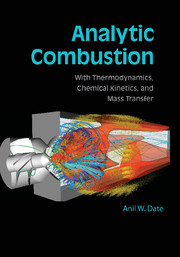Book contents
- Frontmatter
- Contents
- Preface
- Symbols and Acronyms
- 1 Introduction
- 2 Thermodynamics of a Pure Substance
- 3 Thermodynamics of Gaseous Mixtures
- 4 Chemical Equilibrium
- 5 Chemical Kinetics
- 6 Derivation of Transport Equations
- 7 Thermochemical Reactors
- 8 Premixed Flames
- 9 Diffusion Flames
- 10 Combustion of Particles and Droplets
- 11 Combustion Applications
- APPENDIX A Thermochemistry Data
- APPENDIX B Curve-Fit Coefficients for Δhc, Tad, Kp, Cp, h, and s
- APPENDIX C Properties of Fuels
- APPENDIX D Thermophysical and Transport Properties of Gases
- APPENDIX E Atmospheric Data
- APPENDIX F Binary Diffusion Coefficients at 1 atm and T = 300K
- Bibliography
- Index
3 - Thermodynamics of Gaseous Mixtures
- Frontmatter
- Contents
- Preface
- Symbols and Acronyms
- 1 Introduction
- 2 Thermodynamics of a Pure Substance
- 3 Thermodynamics of Gaseous Mixtures
- 4 Chemical Equilibrium
- 5 Chemical Kinetics
- 6 Derivation of Transport Equations
- 7 Thermochemical Reactors
- 8 Premixed Flames
- 9 Diffusion Flames
- 10 Combustion of Particles and Droplets
- 11 Combustion Applications
- APPENDIX A Thermochemistry Data
- APPENDIX B Curve-Fit Coefficients for Δhc, Tad, Kp, Cp, h, and s
- APPENDIX C Properties of Fuels
- APPENDIX D Thermophysical and Transport Properties of Gases
- APPENDIX E Atmospheric Data
- APPENDIX F Binary Diffusion Coefficients at 1 atm and T = 300K
- Bibliography
- Index
Summary
Introduction
In air-conditioning and combustion applications, we encounter essentially gaseous mixtures. In air-conditioning, de-humidification, or humidification, the substance comprises a binary mixture of air + water vapor. The substance is called an inert mixture because no chemical reaction takes place between air and water vapor. In contrast, combustion mixtures are multicomponent mixtures because several chemical species (for example, CmHn, O2, CO, CO2, H2O, NOx, SOx) comprise them. They are not inert because under the right conditions of temperature and pressure, they can react chemically. Hence, they are called reacting mixtures. If the right conditions do not obtain, however, then they are inert mixtures.
Our interest in this chapter is to define mass, volume, and energy properties of gaseous mixtures. In the previous chapter, we noted that the state of a pure compressible substance requires specification of only two independent intensive properties. In contrast, the state of a mixture requires additional information that describes the composition of the mixture. Here, composition refers to the proportions of the components constituting the mixture.
In most applications of interest in this book, pressures are substantially low and temperatures substantially high, so the perfect gas range is obtained. As such, we shall assume that the mixture substance, as well as its components, behaves as a perfect gas. The intensive properties p, v, and T of a perfect gas are related by Equation 2.11.
- Type
- Chapter
- Information
- Analytic CombustionWith Thermodynamics, Chemical Kinetics and Mass Transfer, pp. 48 - 69Publisher: Cambridge University PressPrint publication year: 2011



